AIR LAW
1/73
There's no tags or description
Looks like no tags are added yet.
Name | Mastery | Learn | Test | Matching | Spaced |
|---|
No study sessions yet.
74 Terms
In 1900…
French jurist Fauchille suggested that a code of international air navigation had to be created by the Institut de Droit International.
this is one of the rare moments that the legal process came before technological advances
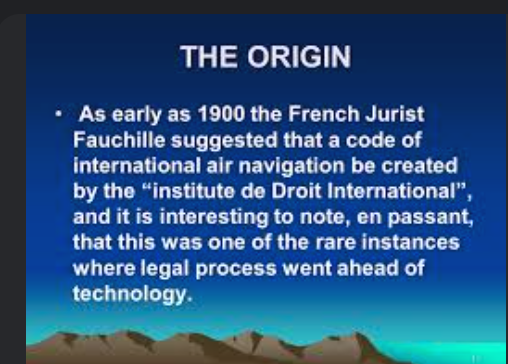
What happened in 1903…
the Wrights Brothers had carried out their first engine powered flight and so aviation became a topical interest
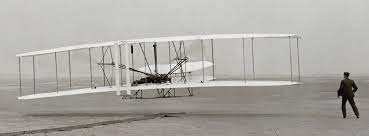
In 1913…
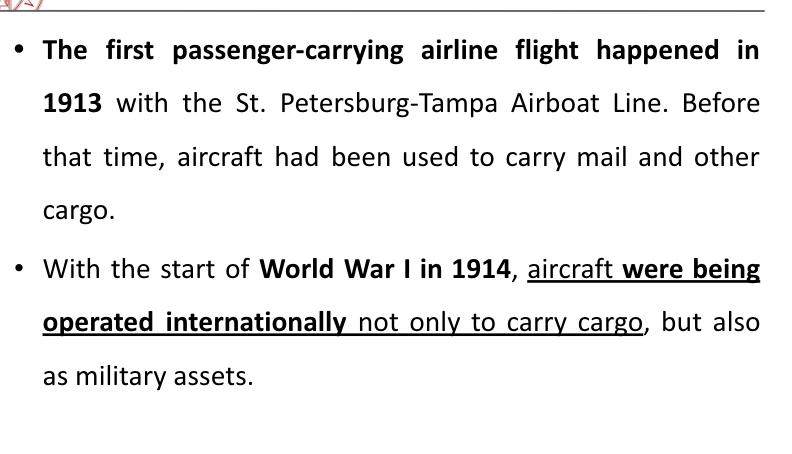
What happened at the start of 1914
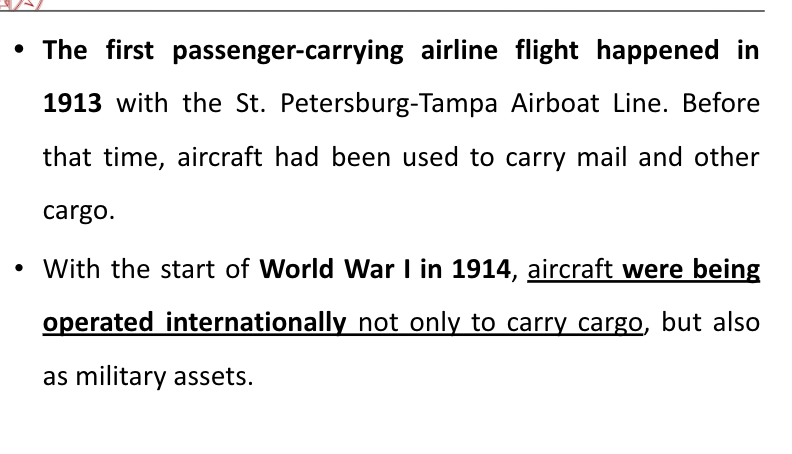
Describe the Paris Convention…
Convention recognised the complete and exclusive sovereignty of States over the airspace above their territory - if they possess the land, then they also possess the air above it
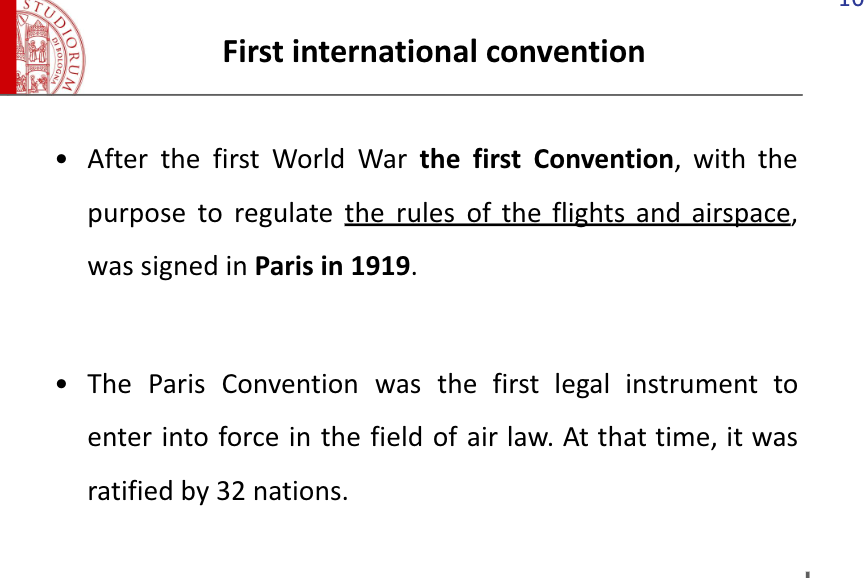
Describe the Chicago Convention
the Chicago convention is legally binding on 193 Member States
Has 3 amendments - 3bis, 83bis, 93bis
Convention is divided into a preamble + 4 parts: •Part I: Air Navigation (a.o. sovereignty of airspace, freedoms of the air, remotely piloted aircraft, air service agreements)
•Part II: The International Civil Aviation Organization (ICAO)
•Part III: International Air Transport
•Part IV: Final Provisions (a.o. War and Annexes)
•19 Annexes
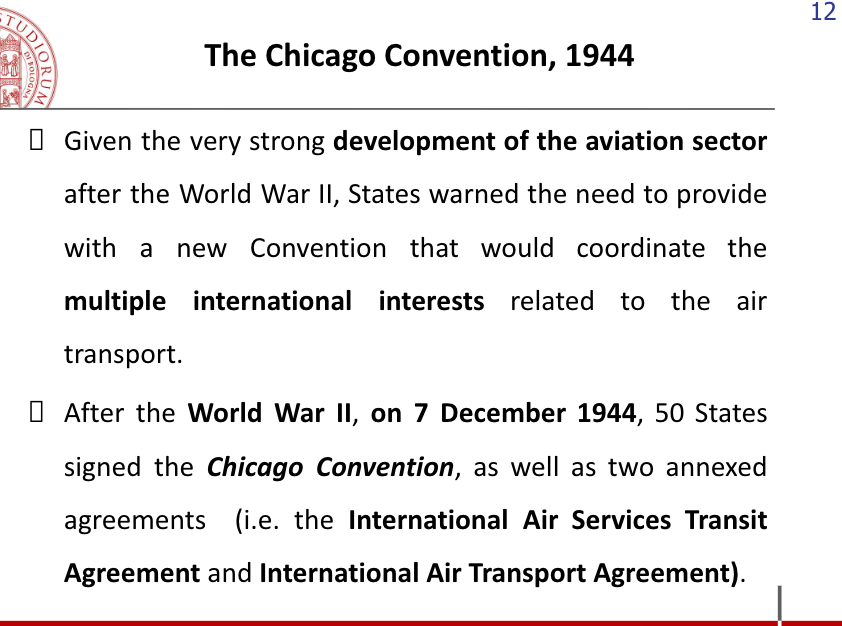
What does ICAO stand for?
Describe its structure
International Civil Aviation Organisation
Assembly meets every 3 years in Montreal
Council - 40 states are represented and elected representatives from National governments
Secretary -
Air transport Bureau
Legal affairs bureau
Air Navigation Commission (ANC)
Describe the ICAO
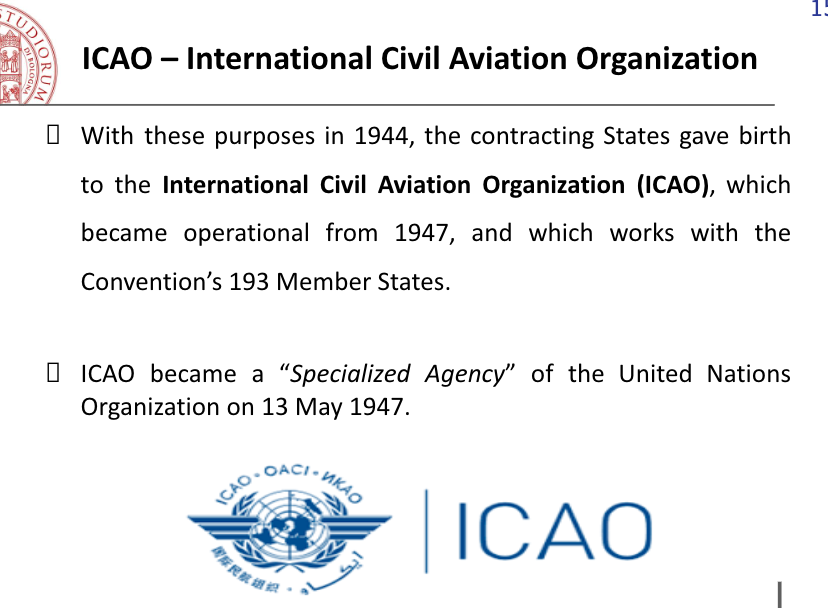
The Sovereignty Principle
At the time of the Chicago Convention, which country dominated the aviation industry and what was the consequence of this?
What was the position of Europe?
What principle did this create?
At the time of the Chicago Convention drafting, the aviation industry was characterized by the dominance of the US which represented the main world power able to provide air transport services around the world, thanks to the great resources dedicated to the aviation industry, US: open to liberalisation of the air transport industry.
On the contrary, the EU countries were less competitive, thus denied a liberal air services policy = they desired a more protectionist and nationalistic policy recognizing the principle of territorial sovereignty over their airspace and providing the routes’ allocation through bilateral agreements.
The sovereignty principle
What is article 1 of the Chicago Convention?
Article 1 recognizes that each State enjoys complete and exclusive sovereignty over the airspace above its territory.
In other words, it’s the exclusive competence of a State to exercise its legislative, administrative and judicial powerswithin its national airspace.
What does article 2 of the Chicago Convention concern?
Territory
“For the purposes of this Convention the territory of a State shall be deemed to be the land areas and territorial waters adjacent thereto under the sovereignty, suzerainty, protection or mandate of such State.”
What does art.3 of the Convention concern?
Applicability
Article 3 Civil and state aircraft (a) This Convention shall be applicable only to civil aircraft, and shall not be applicable to state aircraft.
Restrict the scope of Application only to civil aircraft
Does not give a definition of each one (civil/state):
•Civil aircraft: commercial/general aviation
•State aircraft: a typical representative could be the military aircraft
•BUT: see analysis of Art. 3 b Chicago Convention
In terms of applicability, what does state and civil aircraft mean?

TITLE: The sovereignty principle: The operation of Air services
What does article 6 of the Chicago convention talk about?

What is cabotage?
the right to restrict all services between two points within its territory for the exclusive use of its own subjects.
What does article 7 of the Chicago Convention say on cabotage?
Article 7 of Chicago Convention stipulates that a State may reserve to itself the exclusive right of air transport within its own territorial limits and its overseas territories as well as between those two areas of sovereignty.
What does article 8 of the convention say on pilotless aircraft?
•“No aircraft capable of being flown without a pilot shall be flown without a pilot over the territory of a contracting State without special authorization by that State and in accordance with the terms of such authorization. Each contracting State undertakes to insure that the flight of such aircraft without a pilot in regions open to civil aircraft shall be so controlled as to obviate danger to civil aircraft.”
Greater freedom of movement have been made in two agreements - where can they be found?
What do these agreements do?
Annexed to the Chicago Convention
They divide the freedom of the air into 5 categories
What is ATA?
ØATA: agreement which two nations sign to allow international commercial air transport services between their territories.
ØThey were formulated in 1944 at the international gathering held in Chicago (i.e. the Chicago Convention) in world air commerce.
ØThey recognized the freedom of the Air.
What is the 1st freedom of the air?
the right or privilege, in respect of scheduled international air services, granted by one State to another State or States to fly across its territory without landing
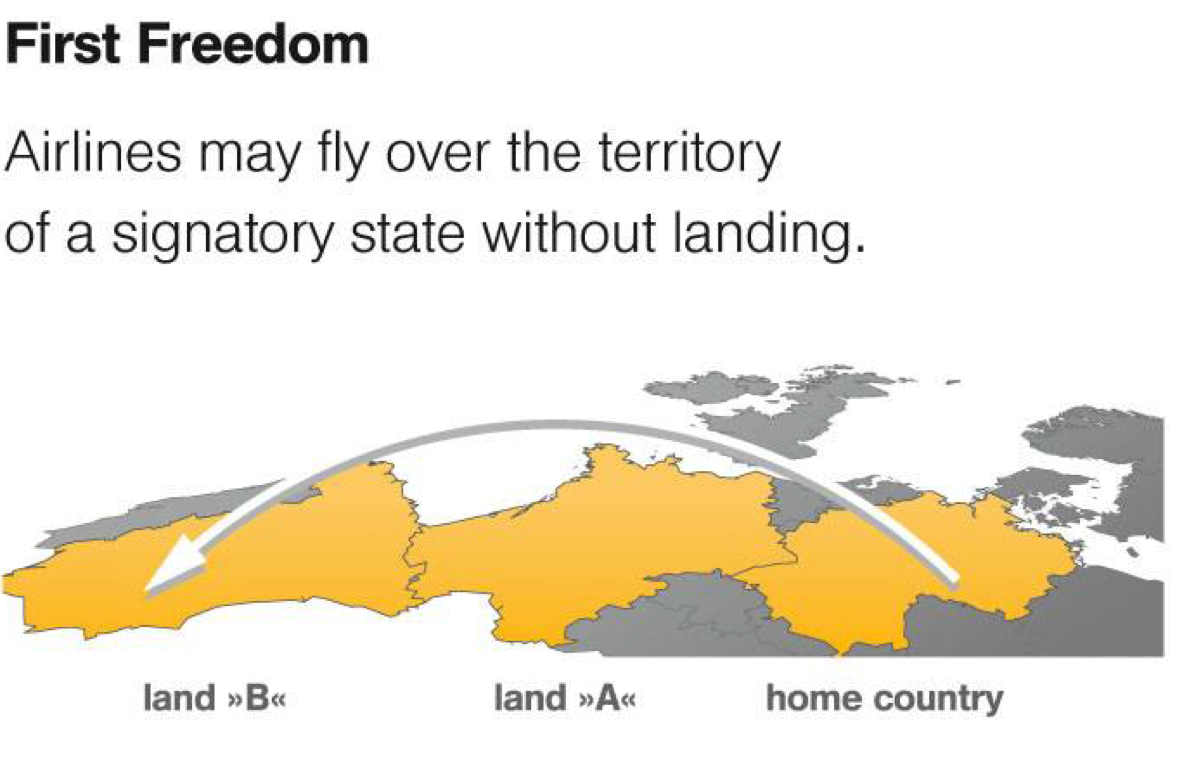
What is the 2nd freedom of the air?
Second Freedom of the Air - the right or privilege, in respect of scheduled international air services, granted by one State to another State or States to land in its territory for non-traffic purposes.
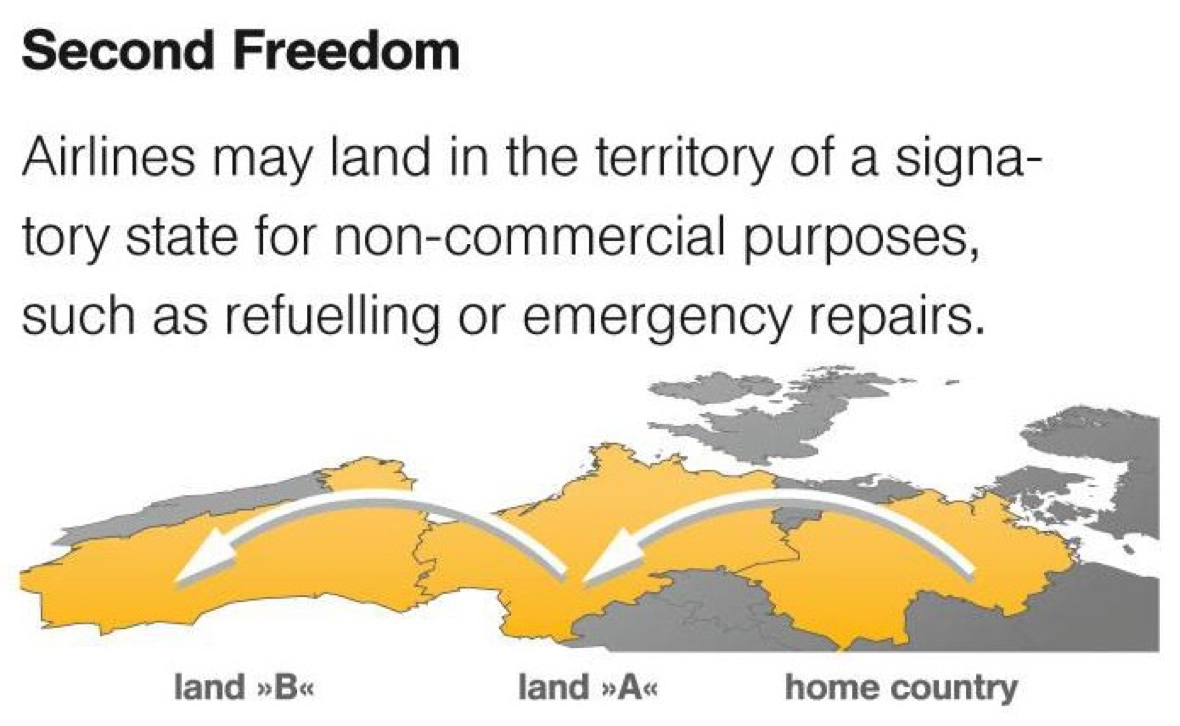
What is the 3rd freedom of the air?
the right or privilege, in respect of scheduled international air services, granted by one State to another State to put down, in the territory of the first State, traffic coming from the home State of the carrier.
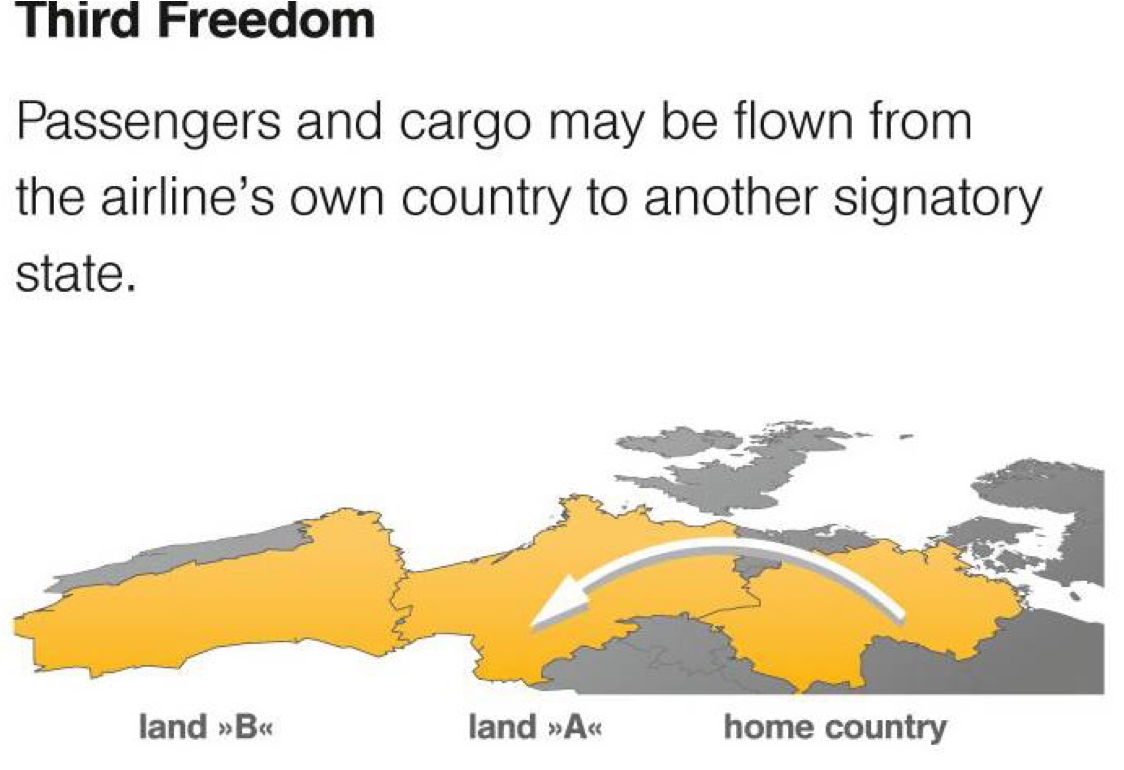
What is the 4th freedom of the air?
the right or privilege, in respect of scheduled international air services, granted by one State to another State to take on, in the territory of the first State, traffic destined for the home State of the carrier.

What is the 5th freedom of the ATA?
- the right or privilege, in respect of scheduled international air services, granted by one State to another State to put down and to take on, in the territory of the first State, traffic coming from or destined to a third State
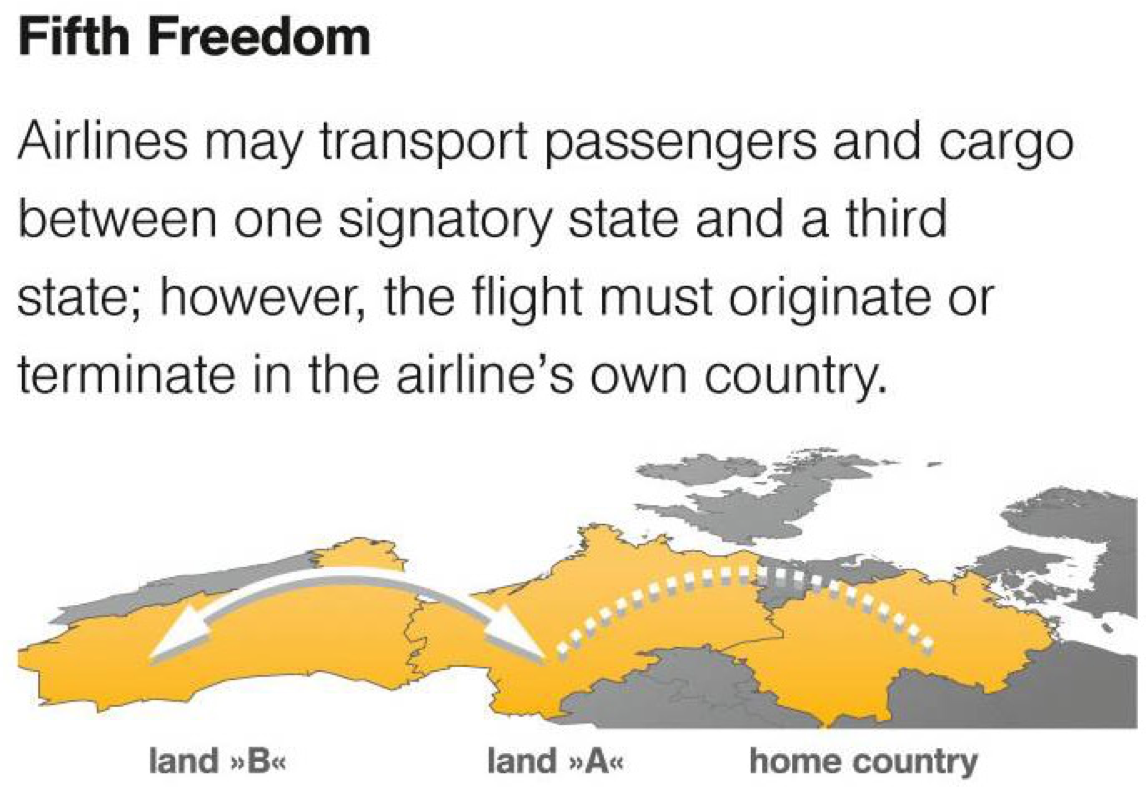
What is the eighth freedom of the ATA?
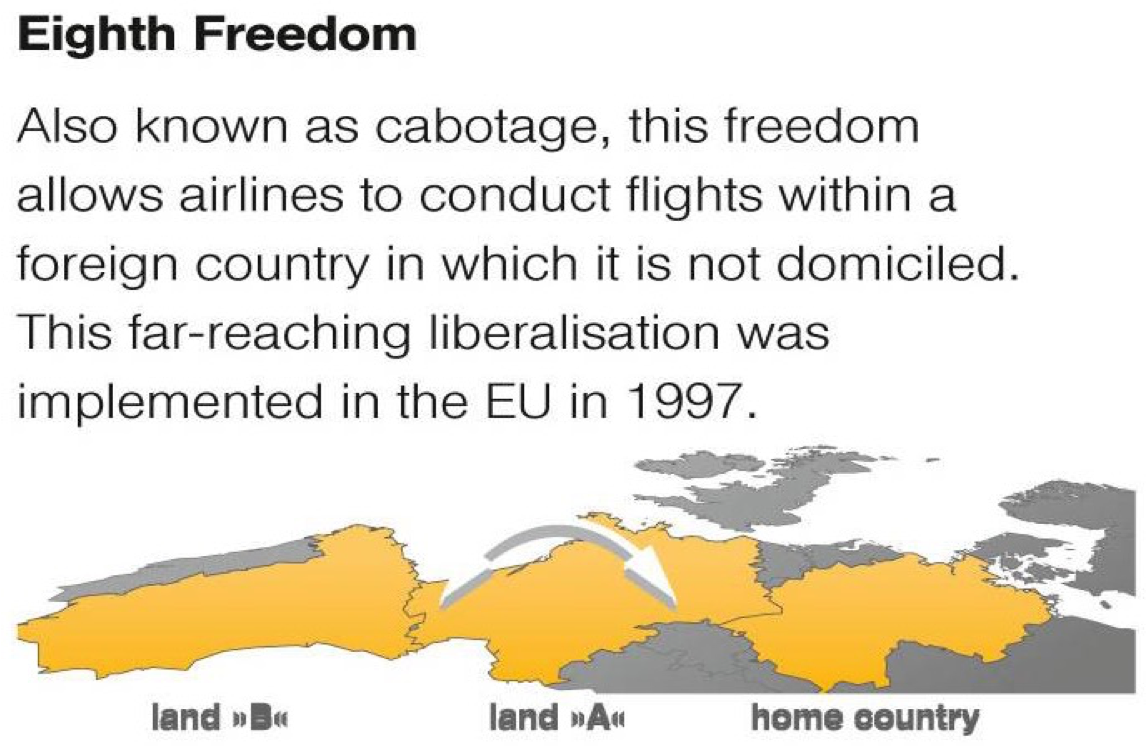
What agreement was signed in Bermuda 11th February 1946?
What does this agreement deal with?
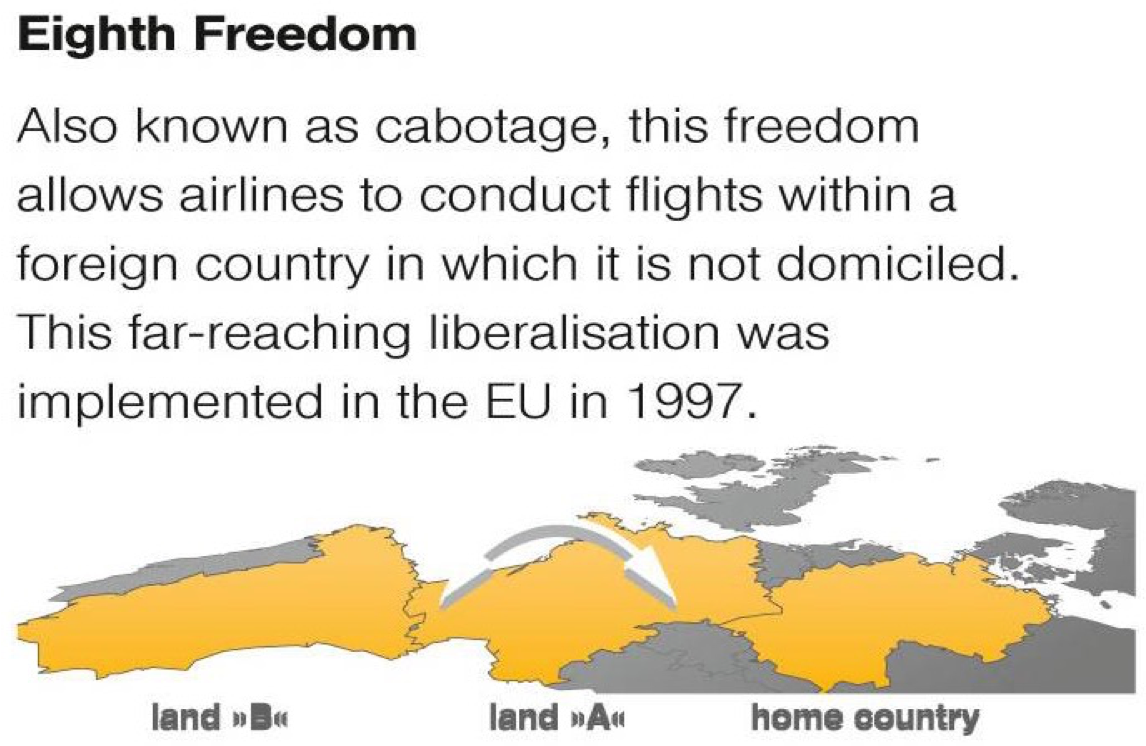
What agreement replaced the Bermuda II agreement?

What was the situation before EU liberalisation?
ØEach State’s sovereignty over its airspace
ØVery limited “freedoms” of the air
ØTraffic rights given by bilateral agreements - Bilateral agreements were usually state vis-a-vis state
ØTraditionally protect national carrier and limit/prohibit competition —> An example of a national airline would be Airitalia. Also airlines had to be owned fully by Italian nationals. This has now been gradually relaxed and now EU citizens only have to be the majority shareholder of the airline.
ØUse only of designated airports
ØOften single airline designation
ØLimited frequencies / capacity
ØDouble approval for fares
ØPooling agreements between airlines
ØMost airlines state-owned - All of the states had OWNERSHIP AND CONTROL PROVISIONS (a nationality clause)
Can you describe the brief history of the EU and the Single aviation market?
•1958 Entry into force of Treaty of Rome (signed March 1957)
•1978 US deregulation - opening up the market to competition)- de-regulation - less rules
•1986 Nouvelles Frontières ECJ - CJEU played an important role in the late 80s - belief that the transport sector and aviation was out of the competition rules: CJEU said that the aviation sector was an integral part of EU law. Articles 101 of competition rules apply to aviation. From that point onwards, it had control of financial aid which governments were giving to airlines.
•1987 Single European Act: it set the EC an objective of establishing a single market by 31 December 1992
•1988 1st air service regulation package enters into force
•1990 2nd package
•1993 3rd package
•2008 Regulation 1008/2008 consolidating and revising 3rd package
EU liberalisation 88-2008 : used to be in packages on regulations. 1st, 2nd, 3rd packages - all of these packages culminated into Reg 1008/2008- constitution of single aviation market in Europe. Have been talking about revising it since COVID. Nothing has yet happened so still in place
Between which years was the liberalisation of air transport in the EU achieved? How was this achieved?
ØThe liberalisation of air transport in the European Union was achieved progressively, between 1987 and 1992, with three packages of Regulations = several sets of EU regulatory measures have gradually turned protected national aviation markets into a competitive single market for air transport;
ØThe first (1987) and the second (1990) “packages” started to relax the rules governing fares and capacities;
ØIn 1992 the “third package” (i.e. Regulations (EEC) N. 2407/92, 2408/92 and 2409/92, now replaced by Regulation (EC) N. 1008/2008) removed all remaining commercial restrictions for European airlinesoperating within the EU, thus setting up the European Single Aviation Market.
EU AIR SERVICES LIBERALISATION:
When did the European Community (now the Union) begin to de-regulate its single market aviation market?
What was the impact of this for O&C?
How many countries are included in the EU single Aviation market today?
ØThe European Community started to deregulate its single aviation market in 1987. Under the provisions of the “third package” coming into effect in 1993, O&C of European air carriers was opened to all EU nationals, provided that an air carrier complied with safety, financial and operational requirements.
ØThe EU Single Aviation Market includes today 28 countries. O&C liberalisation, on a reciprocal basis and in parallel with full regulatory harmonisation based on EU aviation legislation, was further extended to countries of the European Economic Area (EEA) and Switzerland.
Ownership and control belong to two different notions. Ownership = shares. Easy to identify whether a company is owned or not owned by certain people. In europe its 51% to own the company.
US allows only airlines in Europe with ownership by EU citizens of 50% + 1 to fly into their territory
Control can assume different connotations - who sits in the board, who makes the decisions - where the EU Commission (has authority to control the aviation market) - have more difficulties understanding who controls it.
What is the most key component of the Chicago Convention?
SAFETY
What are the 3 KEY ELEMENTS OF 3rd PACKAGE
REGULATION 1008/2008?
•Licensing
•Common requirements for an operating licence (AOC, financial fitness, EU ownership/control (see the following slides)
•If requirements satisfied, licence must be granted
•End to national monopolies (e.g. Aegean in Greece; Alitalia in Italy etc.)
•Common EU area for ownership/control, so freedom for cross-border establishment/takeovers (e.g. KLM UK, TUI)
•Access
•Free access for a holder of an operating licence to any route within the EU
•Including 7th freedom (e.g. easyJet operates from Amsterdam- to Lyon) and 9th freedom (e.g. easyJet from Milan- to Rome)
end to national monopolies e.g in Italy, having airdolomiti and not only airitalia… consequence is free market access. Companies such as Ryanair have dominated the European market- they operate lots of flights at cheap prices… this also has social implications because for example students are able to access social mobility for study purposes.
•Fares → the objective was to reduce fares to make flights more accessible to customers
•Complete freedom of pricing (subject to rules on transparency and competition rules)
Transparency - they have to repeatedly show the price to the customer throughout the booking process.
Rules about competition: the airline cannot be anti-competitive
Describe what is meant by community air carriers?
what is the regulation for this?
What are the requirements that Air Community Carriers must comply with in order to start or continue operations?
No longer have national air carriers but community air carriers - get an air operation certificate
ØThe reg. 1008/2008 laid down the requirements that Community air carriers must comply with in order to start or continue operations, principally:
ØThey shall be owned and effectively controlled by Member States and/or nationals of Member States, and their principal place of business shall be located in a Member State.
e.g Ryanair in Dublin
ØTheir financial situation shall be good. They shall be appropriately insured to cover liability in case of accidents (operating Licence).
Financial situation has to be shown to be viable for at least 3 years. Airlines take a long time to be set up. Have to have a schedule. Inspections for safety.
Have to be insured - main principle of safety as within the Chicago Convention- accidents.
First international convention which was drafted was about liability - was to ensure than companies could grow. Because if a company sets up and then has an accident, they will be bankrupt immediately.
Drones - if you fly a small drone, you have to have insurance
EU want aviation to be a strong commercial industry
ØThey shall have the professional ability and organisation to ensure the safety of operations in accordance with the regulations in force. This ability is evidenced by the issue of an ‘Air Operator Certificate (AOC)’.
Liberalisation Effects:
What has happened to the industry since 1997?
How much has the number of routes increased by?
What has been the impact upon the emergence of new competitors on prices?
In order to bolster this success, a new Regulation consolidated in one text the three regulations of the third aviation package - what is this called?
ØSince the liberalisation of air transport in the EU (1997) the industry has expanded as never before, which has contributed to economic growth and job creation.
ØThe number of routes has increased by more than 60% and now more cities are served, particularly in remote areas - this means that connectivity has also increased.
ØThe emergence of new competitors has brought price reductions on many routes, allowing more Europeans to travel by air.
ØIn order to bolster this success, a new Regulation consolidated in one text the three regulations of the third aviation package [Regulation 1008/2008].
What is Regulation no 1008/2008 Called?
REGULATION (EC) No 1008/2008 OF THE EUROPEAN PARLIAMENT AND OF THE COUNCIL of 24 September 2008 on common rules for the operation of air services in the Community (Recast)
What are the bodies in the EU behind regulation 1008/2008?
The EU Parliament and the council on common rules for the operation of air services within the community
What does reg 1008/2008 regulate?
the licensing of Community air carriers, the right of Community air carriers to operate intra-Community air services and the pricing of intra-Community air services.
What is the Member State responsible for under reg 1008/2008?
the oversight of the air operator certificate and of the operating license

What is the operating licence?
"Operating license" means an authorization granted by the competent licensing authority to an undertaking, permitting it to provide air services as stated in the operating license (art. 2).
What does article 3 of the reg 1008/2008 state?
“No undertaking established in the Community shall be permitted to carry by air passengers, mail and/or cargo for remuneration and/or hire unless it has been granted the appropriate operating license”.
What is the granting and validity of an operating license dependant upon?
The granting and validity of an operating license shall at any time be dependent upon the possession of a valid air operator certificate (AOC) specifying the activities covered by the operating license
What is the difference between the AOC and the Operating License?
While the AOC certifies the technical capacity of an undertakingto safely provide air services, the operating license confers the right to provide commercial air services
EU AIR CARRIERS: What is needed to be considered an EU air carrier? What are they entitled to do?
An air undertaking that has been granted an operating license by a Member State, in accordance with the technical and financial conditions set in Reg. 1008/2008, is considered as a European air carrier and is entitled to provide air services throughout the EU, in and between all the Member States.

What is the public service obligation? When can it be imposed by an EU MS?
What is the purpose of imposing a public service obligation on scheduled air services?

According to Regulation 1008/2008, what is prohibited concerning price discrimination in air travel?
What does Regulation 1008/2008 specify regarding price differences for the same product in air travel?
How does Regulation 1008/2008 contribute to price transparency in air travel?

Part IV: Air Passenger’s Rights:1999, Montreal Convention, Regulation No. 261/2004.
CONTRACTUAL AIR LIABILITY: DESCRIBE THE WARSAW CONVENTION
•Signed in 1929 – 152 State parties
•intended to clarify where claims could be brought and on what rules (“[…] unification of certain rules […]”)
•compromise: low liability limits in return for presumed carrier liability
•amended by Hague Protocol 1955; 137 parties
Part IV: Air Passenger’s Rights:1999, Montreal Convention, Regulation No. 261/2004.
CONTRACTUAL AIR LIABILITY: DESCRIBE THE MONTREAL CONVENTION 1999
Under the 1999 Montreal Convention, what are carriers liable for?
•Signed in 1999 – 139 State parties
•Latest countries to accede: Bangladesh and Nicaragua (2022)
Main objectives:
•Modernise and consolidate the regime outlined in the Warsaw Convention 1929
•Protect the interest of consumers and ensure adequate compensation
SCOPE OF APPLICATION: applies to all international air carriage of persons, baggage or cargo
Creates global uniform legal rules governing airline liability to compensate passengers for bodily injury (or death), baggage loss, and delay during international travel by aircraft.
ØDeath and injury of passengers (Art. 17, I)
Ø Damage to baggage (Art. 17, II)
Ø Damage to cargo (Art. 18)
Ø Delay (Art. 19).
How does the Montreal Convention 1999 and the Warsaw Convention 1929 relate to one another?
•MC99 and WC29 formally independent and respectively in force – MC99 prevails in case of States party to both treaties
What is contractual air liability and what does it stem from?
How does contractual air liability relate to private international air law?
Besides contractual liability, what are some other types of liability in aviation?

What does international carriage mean?
any carriage in which the place of departure and the place of destination are situated either within the territories of two States Parties, or within the territory of a single State Party if there is an agreed stopping place within the territory of another State, even if that State is not a State Party.
What does Article 17(I) say on the Death and injury of passengers?
ØThe carrier is liable for damage sustained in case of death or bodily injury of a passenger
Øonly that the accident which caused the death or injury took place on board the aircraft or in the course of any of the operations of embarking or disembarking.
What does Art 21 of the 1999 Montreal Convention say on the death and injury of passengers?

What does art 17 (II) of the 1999 Montreal Convention say on Damage to Baggage?

What does art 18 of the 1999 Montreal Convention say on Damage to Cargo?

What does art 19 of the 1999 Montreal Convention say on Delay?

What does art 22 of the 1999 Montreal Convention say on Limits of liability in relation to delay, baggage and cargo?

What is the exclusion of punitive damages under the 1999 Montreal Convention?
The MC, 1999 does not cover:
Øpunitive
Øexemplary
Øor any other non-compensatory damages.
Ø “Bodily injury’’ (art. 17) à which damages are recoverable? Does the MC allow for the recovery of psycological/moral damages?
Which persons are entitled to claim damages under the Montreal Convention?

How is bodily injury to be interpreted?

Conventionally when was a plaintiff allowed to recover damages for mental injury?
Conventionally, a plaintiff was allowed to recover damages for mental injury only when it was accompanied by physical injury, the provisions of the Warsaw Convention and Montreal Convention are of exclusive application and have mandatory effect.
In general, recovery for purely mental injuries has been denied by courts as it is difficult to identify which mental injuries are caused by the accident and as a result, can be compensated under international air law.
How does article 17 of the Warsaw Convention relate to bodily injury?

How does Article 17 of the Montreal Convention compare to Article 17 of the Warsaw Convention?

What are the conditions of article 17 Montreal Convention (1999) as to which the plaintiff has to prove for liability to be imposed?
The courts can play a significant role in developing the jurisprudence under the Montreal Convention where on the basis of negotiations, to say the least, it can be inferred by Courts that recovery for mental injury associated with bodily injury is permissible.
